









It is easy to find the maximum radius R(p) of a sphere centred at a point p without overlap with the van der Waals surface of any atom:
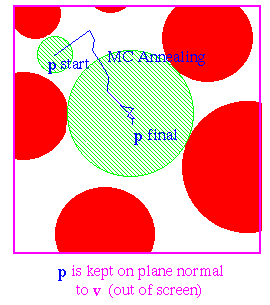
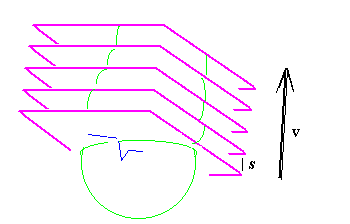
A flow chart giving a detailed description of the basic HOLE method is available.
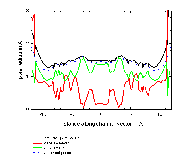
Graphical presentation can be complimented by examination of HOLE objects using a molecular graphics program. Two objects can be produced and displayed in conjunction with the ion channel structural model.
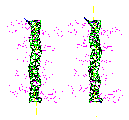
The HOLE package is designed to be used primarily with the quanta molecular graphics program. However, conversion routines are supplied to allow use with:
A recent advance allows an alternative view of the internal surface of a pore - from the inside. In this case we set up a cylindrical co-ordinate system working from the pore centreline:
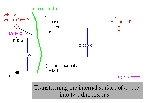
This coordinate system can then be used to display properties of the pore lining in two dimensions. A simple way of imagining how the maps are constructed is to imagine that the internal surface of the pore is cut down a line and then rolled flat. A number of properties of the internal surface of the pore can then be displayed, for instance, whether the surface is lined by oxygen or nitrogen atoms. The versatile contour plotting program surfer is used to process data produced by HOLE. This provides a very different way of looking at the gramicidin channel:
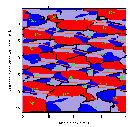
Instead of using a sphere to probe the internal surface of the channel in question a spherocylinder (capsule) is considered. This object can be considered to be a simple extension of a sphere where the centre is spread from a point onto a line section. It can be defined in terms of three properties: two centres and a radius (in comparison to a sphere which has a single centre and a radius):
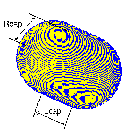
In the HOLE method the axis of the capsule is held at
right angles to the channel direction vector v.
Only small adaptations are required to implement this: instead of
a single centre being considered in the optimization, two independent
centres are introduced. Each of these is constrained to move on
a plane normal to the channel direction vector v. Instead
of optimizing the radius of the sphere as in the original routine
the area of the capsule on the plane normal to v is maximized
(although this is converted in the program into an effective
radius to ease comparisons).
As the number of independent variables is doubled from two to four,
more steps of simulated annealing are required to achieve stability
in results. Despite this increased cpu requirement
most channels can be analyzed in well under one hour of cpu time on
a modern workstation. The result of optimizing a capsule inside the pore
of gramicidin is shown below:
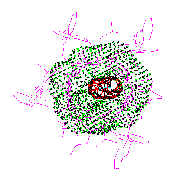
(click to see picture full size)
The difficulty in experimentally determining the three-dimensional structures of ion channels often make it necessary to resort to modelling techniques. Although modelling can lead to insights into the functional and structural properties of channels there is always the problem of knowing what level of confidence to place in the model. For this reason, tractable methods of validating a given model of a channel are required. HOLE has been adapted so that a reasonable prediction of the conductance of a channel can be rapidly made on the basis of its structure11.
The method is based on simple Ohmic considerations. The HOLE program can be thought of as measuring the cross section area A(z) of a pore as a function of distance along the channel direction vector z. Consider the pore to be filled with an electrolytic solution of resisitivity Þ. A reasonable approximation of the resistance of the channel is given by:
 Þ s/A(z)
Þ s/A(z) The above equation assumes that the conductivity of an ionic solution within a channel is equal to that of bulk solution. This would be true if ion channels had macroscopic dimensions (much larger than a water molecule). In practice it is found that real channels have a conductance which is around five times lower than that expected from the above equation giving the macroscopic limit Gmacro. In order to make a reasonable estimate of the conductance of a channel, an empirically-based correction factor is used, which is chosen to be dependent on the minimum radius of the channel:
The correction factor was parameterized11 on the results obtained for the gramicidin channel14 and the E. coli OmpF porin15. The prediction routine was tested by "predicting" the conductance found for all channel-forming proteins and peptides where an experimental structure is available11. Results are summarized in the following graph:
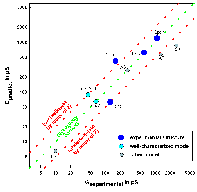
Overall, the algorithm yield good results with predictions accurate to within a average factor of 1.8 to the experimental values. This accuracy is sufficient to make the method a useful part in validating model structures. Further work has been undertaken to reparameterize the correction function on the basis of all well defined structures which were considered11. Future work will involve include using molecular dynamics simulation procedures to find quantities such as the variation of the self-diffusion co-efficient of water molecules within the channel and including such effects within the prediction methodology.
It is also possible to adapt the procedure to predict the effect of adding non-electrolytes such as PEG to conductance measurements. Such experiments can be interpreted in terms of a radius profile for a channel. Encouraging preliminary results11 have been obtained comparing the expected profile calculated by HOLE from the X-ray structure of cholera toxin B subunit19 with the experimental result21.





Oliver S. Smart (last modified 20/12/96)